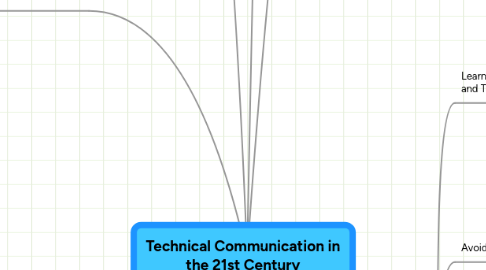
1. Ch. 2: Rhetorical and Technical Communication
1.1. Work Place problems
1.1.1. Percieved
1.1.2. Real Problems
1.2. Rhetorical Problems
1.2.1. Thinking rhetoricaly
1.2.2. Exigency and Purpose
1.2.3. Audiences
1.2.3.1. Expectations and Attitudes
1.2.3.1.1. Positive
1.2.3.1.2. Negative
1.2.3.1.3. Neutral
1.2.3.2. Uses
1.2.4. Workplace Writers
1.2.4.1. Correctness
1.2.4.2. Experience and Expertise
1.2.4.3. Goodwill
1.2.4.4. Identification
1.2.4.5. Trust
1.2.5. Context and Constraints
1.2.6. Document
2. Ch. 3: Technical Communication and Electronic Technologies
2.1. Moore's Law
2.2. Creating Documents
2.2.1. Word Processors
2.2.1.1. HTW: Layouts and Design (p.295)
2.2.2. Presentation Software
2.2.3. Graphics and Imaging Software
2.2.3.1. HTW: Drawings (p.154)
2.2.4. Web-Authoring Software
2.2.5. Desktop Publishing Software
2.2.6. Help and E-Learning Authoring tools
2.2.7. Single-Sourcing Programs
2.3. Communicating and Collaborating
2.3.1. Internet
2.3.1.1. Intranets
2.3.2. World Wide Web
2.3.2.1. HTW: Blog (p.49)
2.3.3. E-mail
2.3.3.1. HTW: E-mail (p.162)
2.3.4. Ethics and Electronic Communication
2.3.4.1. Netiquette
2.3.5. Video Conferencing
2.3.6. Groupeware
3. Ch. 4: Ethics and the Workplace Writer
3.1. What is Ethics?
3.1.1. Metaethics
3.1.2. Normative ethics
3.1.3. Applied ethics
3.2. Ethical Guidelines
3.2.1. EG#1
3.2.1.1. Liability laws
3.2.1.2. Environmental laws
3.2.1.3. Copyright laws
3.2.1.4. Patent laws
3.2.1.5. Trademak and Service Mark laws
3.2.1.6. contract laws
3.2.2. EG#2
3.2.3. EG#3
3.3. Cyberethics
3.3.1. Laws
3.3.2. Social norms
3.3.3. The Market
3.3.4. Architecture
3.3.5. E-mails
3.3.6. Websites
3.3.7. Visuals
3.4. Environmental Ethics
3.4.1. Avoid Unethical writting
3.4.1.1. Don't use Desptive or Evasive Language
3.4.1.2. Don't Obscure or Misrepresent the Issued
3.4.1.2.1. Abstract language
3.4.1.2.2. Jargon
3.4.1.2.3. Emphasis or Suppression of Info
3.4.1.2.4. Visual Rhetoric
3.4.1.2.5. Plagiarism
3.4.1.2.6. Use of Inaccurate Info
4. Ch. 1: Technical and Professional Communication in the Workplace
4.1. Genres
4.1.1. HTW: Manuals (p.315)
4.1.2. HTW: Proposals (p.412 and 456)
4.1.3. HTW: Memos (p.328)
4.2. Characteristics
4.2.1. Rhetorical
4.2.2. Audience Centered
4.2.3. Technology Oriented
4.2.4. Ethical
4.2.4.1. HTW: Ethics in Writing (p.177)
4.2.5. Research Oriented
4.2.6. Profesional
4.2.7. Visual
4.2.7.1. HTW: Visuals (p.552)
4.2.8. Design Centered
4.2.9. Concise
4.3. Activities
4.4. Solving Problems
4.4.1. PSA
4.4.1.1. Plan
4.4.1.2. Research
4.4.1.3. Draft
4.4.1.4. Review
4.4.1.5. Distribute
5. Ch. 5: Technical Communication in a Transnational World
5.1. Learning about Transnational and Transcultural differences.
5.1.1. Language
5.1.2. Technology
5.1.3. Education
5.1.4. Politics and Laws
5.1.5. Economy
5.1.6. Society
5.1.7. Religion
5.2. Avoid Stereotypes
5.2.1. Avoid Assumptions
5.2.1.1. HTW: Biased Language (p. 46)
5.2.2. Ask questions
5.2.3. Collaborate with translator
5.3. Enhancing Translations
5.3.1. Terminology
5.3.1.1. HTW: English, Varieties of (p. 173)
5.3.2. Clarity
5.3.2.1. HTW: Clarity (p.68)
5.3.3. Cultural and Rhetorical differences
5.3.4. Design
5.4. Accommodating Transnational Audiences
5.4.1. Localization
5.4.2. Internationalization
5.4.3. Globalization
5.4.4. Verbal Communication
5.5. Transnational Ethics
5.6. Guidelines for Writing for Transnational Auciences
5.6.1. Write Clearly
5.6.1.1. Include Articles
5.6.1.2. Correct Punctuation
5.6.1.3. Avoid Pronouns
5.6.1.4. Use Terminology Consistently
5.6.1.5. Avoid Idiomatic Language
5.6.1.6. Avoid Comparatives
5.6.2. Localize your writing
5.6.2.1. Recognize Alphabetic Differenses
5.6.2.2. Use Local Numbers
5.6.2.3. Be Alert to Time Differences
5.6.2.4. Avoid References to Holidays
5.6.2.5. Avoid Cultural References
5.6.2.6. Avoid Humor
5.6.3. Account for Visual and Auditory Prerceptions
5.6.3.1. Consider Visual Interpretations
5.6.3.2. Avoid Images of People and Hand Gestures
5.6.3.3. Reevaluate Design Elements and Principles
5.6.3.4. Account for Differences in Sound Interpretations
6. Ch. 7: Organizing and Drafting Documents
6.1. Predrafting Strategies
6.1.1. PSA
6.1.1.1. Confirm Your Purpose
6.1.1.2. Analyze Audience
6.1.1.3. Gather Info
6.1.1.4. Develop Ideas about the Info
6.1.1.4.1. Collaboration and Discussion
6.1.1.4.2. Listing
6.1.1.4.3. Freewriting
6.1.1.4.4. Clustering
6.1.1.5. Organize your Info
6.1.1.5.1. Sequential
6.1.1.5.2. Chronological
6.1.1.5.3. Order of Importance
6.1.1.5.4. General/Specific
6.1.1.5.5. Division
6.1.1.5.6. Classification
6.1.1.5.7. Cause and Effect
6.1.1.5.8. Comparison/Contrast
6.1.1.5.9. Spatial
6.1.1.6. Outline Your Important Ideas
6.2. Writing The Draft
6.2.1. Parts of a Document
6.2.2. A Nonlinear Process
6.2.3. Drafting body
6.2.3.1. Coverage and Length
6.2.3.2. Organization and Access
6.2.4. Drafting Conclusion
6.2.4.1. HTW: Conclusions (p. 93)
6.2.5. Drafting Intro
6.2.5.1. HTW: Introductions (p.279)
6.2.5.1.1. Purpose/Objective
6.2.5.1.2. Scope
6.2.5.1.3. Statement of Problem
6.2.5.1.4. Relevant Info/Background
6.2.5.1.5. Key Terms
6.2.5.1.6. Overview of Organization
6.2.5.1.7. Summary
